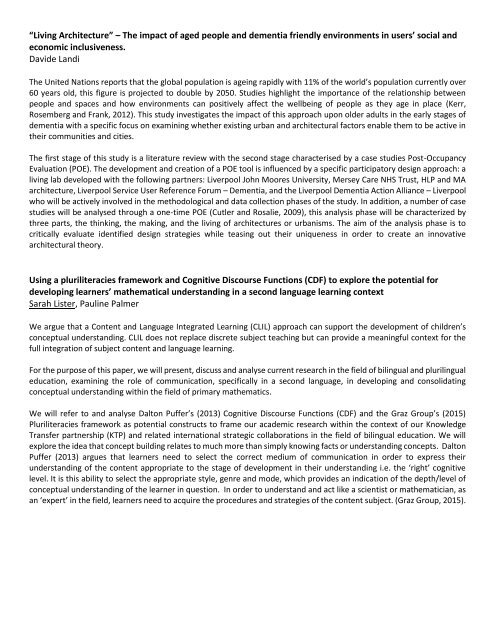Conference Programme FULL (1)
Create successful ePaper yourself
Turn your PDF publications into a flip-book with our unique Google optimized e-Paper software.
“Living Architecture” – The impact of aged people and dementia friendly environments in users’ social and<br />
economic inclusiveness.<br />
Davide Landi<br />
The United Nations reports that the global population is ageing rapidly with 11% of the world’s population currently over<br />
60 years old, this figure is projected to double by 2050. Studies highlight the importance of the relationship between<br />
people and spaces and how environments can positively affect the wellbeing of people as they age in place (Kerr,<br />
Rosemberg and Frank, 2012). This study investigates the impact of this approach upon older adults in the early stages of<br />
dementia with a specific focus on examining whether existing urban and architectural factors enable them to be active in<br />
their communities and cities.<br />
The first stage of this study is a literature review with the second stage characterised by a case studies Post-Occupancy<br />
Evaluation (POE). The development and creation of a POE tool is influenced by a specific participatory design approach: a<br />
living lab developed with the following partners: Liverpool John Moores University, Mersey Care NHS Trust, HLP and MA<br />
architecture, Liverpool Service User Reference Forum – Dementia, and the Liverpool Dementia Action Alliance – Liverpool<br />
who will be actively involved in the methodological and data collection phases of the study. In addition, a number of case<br />
studies will be analysed through a one-time POE (Cutler and Rosalie, 2009), this analysis phase will be characterized by<br />
three parts, the thinking, the making, and the living of architectures or urbanisms. The aim of the analysis phase is to<br />
critically evaluate identified design strategies while teasing out their uniqueness in order to create an innovative<br />
architectural theory.<br />
Using a pluriliteracies framework and Cognitive Discourse Functions (CDF) to explore the potential for<br />
developing learners’ mathematical understanding in a second language learning context<br />
Sarah Lister, Pauline Palmer<br />
We argue that a Content and Language Integrated Learning (CLIL) approach can support the development of children’s<br />
conceptual understanding. CLIL does not replace discrete subject teaching but can provide a meaningful context for the<br />
full integration of subject content and language learning.<br />
For the purpose of this paper, we will present, discuss and analyse current research in the field of bilingual and plurilingual<br />
education, examining the role of communication, specifically in a second language, in developing and consolidating<br />
conceptual understanding within the field of primary mathematics.<br />
We will refer to and analyse Dalton Puffer’s (2013) Cognitive Discourse Functions (CDF) and the Graz Group’s (2015)<br />
Pluriliteracies framework as potential constructs to frame our academic research within the context of our Knowledge<br />
Transfer partnership (KTP) and related international strategic collaborations in the field of bilingual education. We will<br />
explore the idea that concept building relates to much more than simply knowing facts or understanding concepts. Dalton<br />
Puffer (2013) argues that learners need to select the correct medium of communication in order to express their<br />
understanding of the content appropriate to the stage of development in their understanding i.e. the ‘right’ cognitive<br />
level. It is this ability to select the appropriate style, genre and mode, which provides an indication of the depth/level of<br />
conceptual understanding of the learner in question. In order to understand and act like a scientist or mathematician, as<br />
an ‘expert’ in the field, learners need to acquire the procedures and strategies of the content subject. (Graz Group, 2015).


